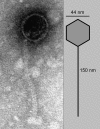An inducible lambdoid prophage encoding cytolethal distending toxin (Cdt-I) and a type III effector protein in enteropathogenic Escherichia coli
- PMID: 17726095
- PMCID: PMC1964815
- DOI: 10.1073/pnas.0706695104
An inducible lambdoid prophage encoding cytolethal distending toxin (Cdt-I) and a type III effector protein in enteropathogenic Escherichia coli
Abstract
Cytolethal distending toxins (CDTs) are inhibitory cyclomodulins, which block eukaryotic cell proliferation and are produced by a diverse group of Gram-negative bacteria, including Escherichia coli strains associated with intestinal and extraintestinal infections. However, the mode of transmission of the toxin gene clusters among diverse bacterial pathogens is unclear. We found that Cdt-I produced by enteropathogenic E. coli strains associated with diarrhea is encoded by a lambdoid prophage, which is inducible and infectious. The genome of Cdt-I converting phage (CDT-1Phi) comprises 47,021 nucleotides with 60 predicted ORFs organized into six genomic regions encoding the head and tail, virulence, integrase, unknown functions, regulation, and lysis. The genomic organization of CDT-1Phi is similar to those of SfV, a serotype-converting phage of Shigella flexneri, and UTI89, a prophage identified in uropathogenic E. coli. Besides the cdtI gene cluster, the virulence region of CDT-1Phi genome contains sequences homologous to a truncated cycle inhibiting factor and a type 3 effector protein. Mutation analysis of susceptible E. coli strain C600 suggested that the outer membrane protein OmpC is a putative receptor for CDT-1Phi. CDT-1Phi genome was also found to integrate into the host bacterial chromosome forming lysogens, which produced biologically active Cdt-I. Furthermore, phage induction appeared to cause enhanced toxigenicity of the E. coli strains carrying lysogenic CDT-1Phi. Our results suggest that CDT-1Phi is the latest member of a growing family of lambdoid phages encoding bacterial cyclomodulins and that the phage may have a role in horizontal transfer of these virulence genes.
Conflict of interest statement
The authors declare no conflict of interest.
Figures



Similar articles
-
Evolution of a self-inducible cytolethal distending toxin type V-encoding bacteriophage from Escherichia coli O157:H7 to Shigella sonnei.J Virol. 2013 Dec;87(24):13665-75. doi: 10.1128/JVI.02860-13. Epub 2013 Oct 9. J Virol. 2013. PMID: 24109226 Free PMC article.
-
Cytolethal distending toxin type I and type IV genes are framed with lambdoid prophage genes in extraintestinal pathogenic Escherichia coli.Infect Immun. 2009 Jan;77(1):492-500. doi: 10.1128/IAI.00962-08. Epub 2008 Nov 3. Infect Immun. 2009. PMID: 18981247 Free PMC article.
-
Sequence variability of P2-like prophage genomes carrying the cytolethal distending toxin V operon in Escherichia coli O157.Appl Environ Microbiol. 2013 Aug;79(16):4958-64. doi: 10.1128/AEM.01134-13. Epub 2013 Jun 14. Appl Environ Microbiol. 2013. PMID: 23770900 Free PMC article.
-
Necrotoxic Escherichia coli (NTEC): two emerging categories of human and animal pathogens.Vet Res. 1999 Mar-Jun;30(2-3):221-33. Vet Res. 1999. PMID: 10367356 Review.
-
Cytolethal distending toxin (CDT): a bacterial weapon to control host cell proliferation?FEMS Microbiol Lett. 2001 Sep 25;203(2):141-8. doi: 10.1111/j.1574-6968.2001.tb10832.x. FEMS Microbiol Lett. 2001. PMID: 11583839 Review.
Cited by
-
Regulation of expression and secretion of NleH, a new non-locus of enterocyte effacement-encoded effector in Citrobacter rodentium.J Bacteriol. 2008 Apr;190(7):2388-99. doi: 10.1128/JB.01602-07. Epub 2008 Jan 25. J Bacteriol. 2008. PMID: 18223087 Free PMC article.
-
Evolution of a self-inducible cytolethal distending toxin type V-encoding bacteriophage from Escherichia coli O157:H7 to Shigella sonnei.J Virol. 2013 Dec;87(24):13665-75. doi: 10.1128/JVI.02860-13. Epub 2013 Oct 9. J Virol. 2013. PMID: 24109226 Free PMC article.
-
Cytolethal distending toxin type I and type IV genes are framed with lambdoid prophage genes in extraintestinal pathogenic Escherichia coli.Infect Immun. 2009 Jan;77(1):492-500. doi: 10.1128/IAI.00962-08. Epub 2008 Nov 3. Infect Immun. 2009. PMID: 18981247 Free PMC article.
-
Exploring the DNA mimicry of the Ocr protein of phage T7.Nucleic Acids Res. 2012 Sep;40(16):8129-43. doi: 10.1093/nar/gks516. Epub 2012 Jun 7. Nucleic Acids Res. 2012. PMID: 22684506 Free PMC article.
-
Cytolethal distending toxin: a conserved bacterial genotoxin that blocks cell cycle progression, leading to apoptosis of a broad range of mammalian cell lineages.Microbiology (Reading). 2011 Jul;157(Pt 7):1851-1875. doi: 10.1099/mic.0.049536-0. Epub 2011 May 12. Microbiology (Reading). 2011. PMID: 21565933 Free PMC article. Review.
References
Publication types
MeSH terms
Substances
Associated data
- Actions
LinkOut - more resources
Full Text Sources

